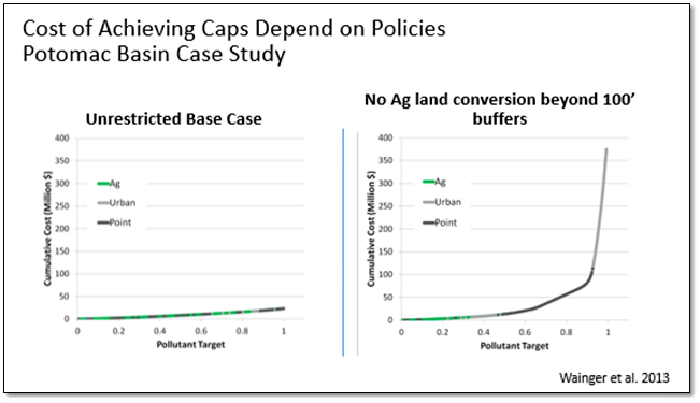For What It’s Worth: Costs and Complexities in Environmental Economics
Katrina Kelly ·Have you ever wondered, how much is our environment worth?1 If you had to put a price tag on the environment, what would it be? Millions of dollars? Billions? Ecological Economist, Robert Costanza, et al.2, estimate that the ecosystem services3 and functions our environment provides, are worth an average of about $33 trillion annually. Our Environment and Society class discussed this topic last week, led by Dr. Lisa Wainger, guest lecturer and research professor of environmental economics at the University of Maryland Center for Environmental Science, Chesapeake Biological Laboratory. Through Dr. Wainger's comprehensive lecture and the Q&A session that followed, we discovered that it is not only possible to evaluate the worth of the environment, but essential to enabling the enactment of effective environmental policy and monitor its ongoing progress.

What is Environmental Economics?
When you hear the word "economics", your mind default to the Bloomberg report, home loan interest rates, or the stock market indices to back them up. Environmental economics does share some of the tenets of traditional economics, but it is by no means the linear cost theory model that one might expect. It operates on a foundation of conventional economic theories nuanced for the best management of: (1) environmental externalities, (2) common property and the public good, (3) natural resources, and (4) economic valuation of environmental goods and services4. Dr. Wainger highlighted four (4) key concepts - economic value, moral philosophy, valuation, and efficient environmental policy - that define environmental economics in practice. As a discipline, it seeks to provide tools and data that help limit market failures and externalities, and efficiently manage common property resources and public goods to the advantage of as much of society as possible.
Key Concept #1: Economic Value
The first concept considers what an environmental good is worth in terms of market price, utility, and its Total Economic Value (TEV). This can be more challenging than it sounds because both use and non-use values5 are weighed as economic indicators in this equation. Many people, for example, enjoy going to the beach. Activities like sun-bathing, fishing, or boating represent direct use of this resource; an indirect use value would be the ocean's role in the hydrologic cycle6 which is a major engine for sustaining life on our planet. On the other hand, there are non-use or passive use values for this same good, the ocean. Perhaps you are not a fan of the beach, but you enjoy the fact that it is available for others now and in the future, or that it exists, period. That, too, represents a part of the TEV. One challenge if this were used as a sole indicator is that it is subjective and therefore does not lend itself easily to quantification. To balance this, Environmental economists will use surveys, market research, consumer surplus data to assist with defining these metrics.
Key Concept #2: Moral Philosophy
Operating from the perspective of societal benefit, economic methods infer that people make decisions based on what benefits them or satisfies their wants or needs. A policy is generally determined to be viable if more people benefit from a policy than do not benefit. An example of how this process is provided in the Goulder and Parry article, "Instrument Choice in Environmental Policy."7 As with traditional economics, there is necessary consideration given to costs associated with imposed policies and their potential impact on industry, society, the economy, and the environment.
Key Concept #3: Valuation and Public Policy
Many are aware of the mission of the Environmental Protection Agency (EPA) and their role in environmental management. The Goulder and Parry article introduces some of the tools used by the EPA to limit air pollution -emissions taxes, regulatory policies, tradable allowance systems - and their relative value in practice. The EPA used analyses compiled by environmental economists to inform decisions about emissions control policies. Environmental economics conducts cost-benefit analyses (CBA) to measure if the benefits of a policy are greater than the costs of imposing and maintaining a policy. A policy or project is deemed "socially efficient" and "in society's best interest "under such conditions. The cost-effective analyses (CEA) are a metric for determining whether a project or policy has an acceptable cost to benefit ratio and seeks the least expensive pathway to achieving the desired result. Governmental bodies like the Environmental Protection Agency (EPA), will refer to these analyses to determine whether (or not) to regulate the use of materials, practices, etc. that threaten public safety and well-being.

Key Concept #4: Efficient Environmental Policy
The final concept encompasses the previous three in that it focuses on accomplishing the goal of best management practices of environment-related issues in the most efficient manner possible. Analytical instruments like CBA, CEA, and TEV, are part of the arsenal of tools used to propose and evaluate an environmental policy that achieves its aims at costs that are conservative in comparison to anticipated benefits. Organizations like the Environmental Protection Agency and other decision-makers rely on such analyses to review environmental policy and protect the public. This is often a balancing act between benefits and tradeoffs,
There are, of course, problems with adhering to strict economic formulas or data analysis for decision-making, including risk factors associated with policy and practices. As Van Houtven & Cropper noted, in their article, "When is a Life Too Costly to Save: The Evidence from U.S. Environmental Regulations"8 the distribution of risk requires consideration and risk equity must be weighed across populations and individuals (Van Houtven & Cropper, 1996). It is important to consider how social capital may be weighted to the advantage of certain individuals or groups and, conversely, disproportionately to the disadvantage of others. This point was underscored by a classmate who shared the article "Implications of Limiting CO2 Concentrations for Land Use and Energy"9 and asked about how environmental economics and policy deals with the problem of "leakage" - negative impacts that emerge from environmental interventions established to correct or control other negative effects. Dr. Wainger acknowledged that this is one of the complexities for which environmental economics' valuation models are equipped to consider, adding that, "Being a systems thinker is the best way to good environmental policy." So, what does this mean for the rapidly evolving and diverse field of environmental management?

Use, Utility, and the Future of the Environment
If nations are to progress in the race to the 2030 Sustainable Development Goals10 with any degree of precision, reliable and replicable tools are required. Environmental economics is a rapidly evolving approach to doing exactly that, helping stakeholders and decisionmakers assess impacts from the perspective of natural resource management, climate change, environmental externalities, and the application of resources and policy to address them. The future of environmental management is interdisciplinary11 - natural resource management, science, policy, academia, industry, technology12, tradespeople, and engaged communities working in concert to respond to issues that impact us all.
It is possible to see witness this awakening at many levels of society - from websites like Ecosia13 and OceanHero14 that are engineered for point-and-click activism, to the Coors Seltzer River Project15 that is giving back to nature while strengthening and perhaps expanding brand loyalty, and countries expanding their concept of what else is worthy of measuring16. The natural environment is the ultimate in nourishment, recreation, education, entertainment, and sanctuary. While it is necessary for the sake of management and policy that we quantify its value, the fact is that in many ways, our environment is of infinite, immeasurable value. We need access to nature17, and not just for tangible resources. In my view, our natural environment is a living, evolving work of art. My time spent observing nature and the photos I capture are sources of sacredness and awe that have no duplicate or substitute. Dr. Wainger concluded the other day with "for what it's worth " referring to her lecture. Tools like environmental economics are a key part of helping to manage and preserve this irreplaceable and infinitely valuable resource that we inhabit and enjoy. That is worth quite a lot.

CITATIONS
- Steiner, A. (2015, October 08). How Much Is the Environment Worth? Retrieved October 12, 2020, from https://time.com/4065215/environment-price/
- Costanza, R. (2020). Valuing natural capital and ecosystem services toward the goals of efficiency, fairness, and sustainability. Ecosystem Services, 43, 101096. doi:10.1016/j.ecoser.2020.101096
- Supporting services. (n.d.). Retrieved October 12, 2020, from http://www.fao.org/ecosystem-services-biodiversity/background/supporting-services/en/
- Harris, J. M., & Roach, B. (2018). Environmental and natural resource economics: A contemporary approach (4th ed.). New York, NY, NY: Routledge. https://www.routledge.com/Environmental-and-Natural-Resource-Economics-A...
- Wainger, Lisa A. & Helcoski, Ryan & Farge, Kevin W. & Espinola, Brandy A. & Green, Gary T., 2018. "Evidence of a Shared Value for Nature," Ecological Economics, Elsevier, vol. 154(C), pages 107-116. https://ideas.repec.org/a/eee/ecolec/v154y2018icp107-116.html
- Hydrologic Cycle. (n.d.). Retrieved October 12, 2020, from https://gpm.nasa.gov/education/water-cycle/hydrologic-cycle
- Van Houtven, G., & Cropper, M. L. (1996). When is a Life Too Costly to Save? The Evidence from U.S. Environmental Regulations. Journal of Environmental Economics and Management, 30(3), 348-368. doi:10.1006/jeem.1996.0024
- Goulder, L. H., & Parry, I. W. (2008). Instrument Choice in Environmental Policy. Review of Environmental Economics and Policy, 2(2), 152-174. doi:10.1093/reep/ren005
- Wise, M., Calvin, K., Thomson, A., Clarke, L., Bond-Lamberty, B., Sands, R., Edmonds, J. (2009). Implications of limiting co-concentrations for land use and energy. Science, 324(5931), 1183-1186. https://science.sciencemag.org/content/324/5931/1183.full
- Sustainable Development Goals. (n.d.). Retrieved October 12, 2020, from https://www.undp.org/content/undp/en/home/sustainable-development-goals....
About the author
Katrina Kelly

Katrina Kelly is a first year master’s student of Environmental Science in the Marine Estuarine Environmental Sciences program at the University of Maryland Eastern Shore, Department of Natural Sciences. She is advised by Dr. Joseph Pitula. She previously worked and assisted in research involving oyster restoration for water filtration functioning in the Chesapeake Bay with the Healthy Harbor Initiative in Baltimore City, and assisted with the Urban Pest Project with Drs. Loren Henderson and Dawn Biehler at UMBC, studying the social impact of bed bug infestations. She is interested in sustainable urban development and planning as well stormwater management/flooding impacts on lower-income and historically marginalized communities.

